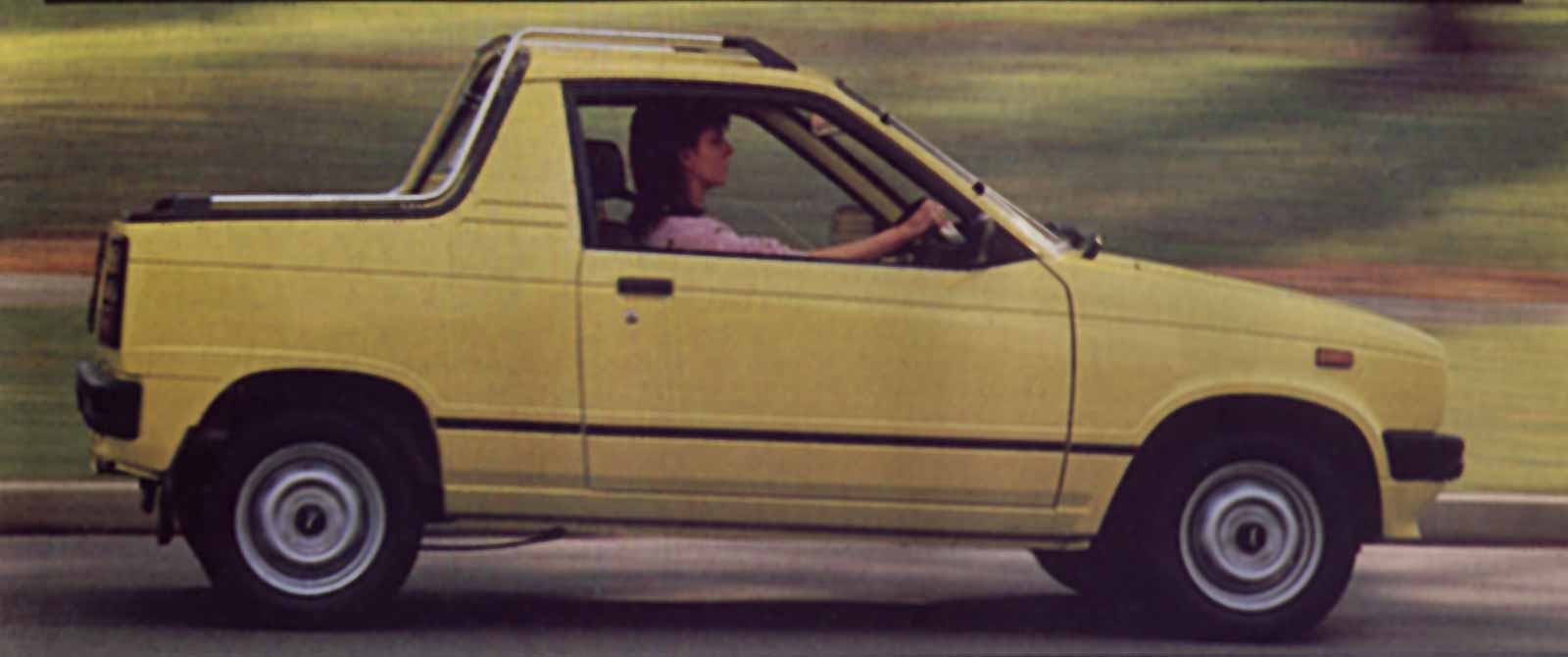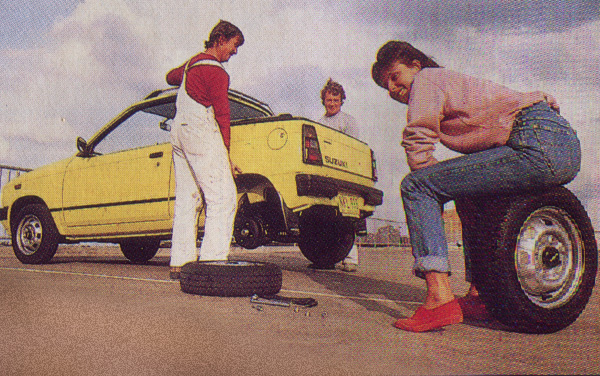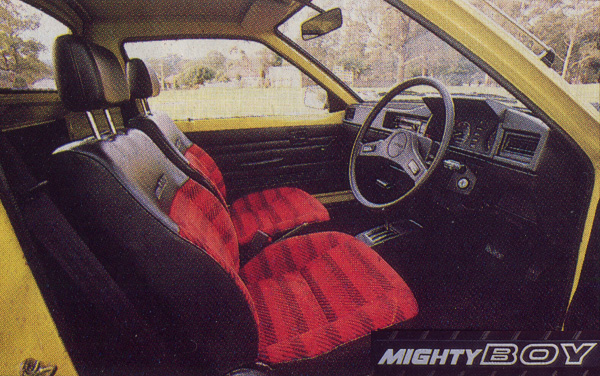

The Mighty Boy might look like a toy, but it’s practical, and sometimes it’s even fun.
It’s cute, cheeky even, and its the cheapest car — or car–type commercial — in Australia. Just $5795 gets you a manual Suzuki Mighty Boy, and for anyone but a hard–core enthusiast, that sticker price is enough to overcome a few glaring deficiencies which are not cost–related; the car’s designers simply got a couple of things wrong.
The Mighty Boy’s worst point is its awful ride on anything less than perfect roads. This is accentuated by its second worst aspect — its seats. But against these shortcomings are its quite adequate performance in short city and suburban trips (if you don’t mind a few revs it will stay between 80 and 120 km/h in a 110 zone), its terrific economy (a best of 4.7 litres per 100 km), and… its price.
Cute Ute – Modern Motor magazine
November 1985
Words
Jeff Brown
Photos
Kent Mears
That, naturally, is what Suzuki is pushing in its advertising for the Mighty Boy, along with its cheeky looks. A lot is also being made of it being fun to drive. Yes, it does have a certain cheeky appeal, and although it’s a long way short of being charismatic, it’s definitely non–conformist in Australia, where we see few micro–minis compared to countries in Europe, and particularly in Asia.
But fun to drive… well, yes, sometimes, in the city, when the pedestrians are smiling down at you as they read the Mighty Boy badges. Or when you find a perfectly smooth, ideally cambered series of downhill bends and you do a version of Ayrton Senna in his karting days and amaze drivers of normal width cars. With just 1395mm width door handle to door handle, even a comparatively narrow road is wide in this little number.
The rest of the time the Mighty Boy is simply economical transport.
On smooth roads its roadholding is actually fairly good; it understeers gently, unless a bump appears. It has surprisingly good grip (in the dry) and can honk quite happily through the aforementioned ideally cambered, smooth, downhill bends. Uphill there are no worries about understeer or oversteer. In fact a winding uphill road becomes an amusing exercise in keeping up momentum and not easing off the throttle for anything, straightening out bends as if the single lane was double lanes in a “real” car.

Apart from the appeal of being able to drive a car absolutely flat stick without being badly illegal or dangerous, the Mighty Boy is also appealing as a practical city and suburban min commercial, for couriers, or people like photographers, models and shopkeepers, because it can carry surprisingly bulky loads in the tray area and there’s also a fairly generous cargo area behind the two seats.
A load (maximum payload is 440kg) improves the Suzuki’s ride comfort considerably, but the heavier the load the slower it accelerates, and with a standing 400m time of 22.43 seconds when empty, the Mighty Boy doesn’t need slowing up. Its weight to power ratio of 24.6kg/kW is double that of a Honda Civic’s…

A lot of the Mighty Boy’s ride problems are related to its short wheelbase and the stiff rear leaf springs: the front MacPherson struts dot their work quite well, but on a series of bumps, or road joining strips where both rear wheels hit the bump simultaneously, the Mighty Boy produced a combination of pitching and bouncing at the rear end that had this five–foot–ten tester lightly cracking his head against the roof on his favourite bumpy horror road. This was at about 90km/h, where most Mighty Boy buyers would travel sensibly (but still bouncily) at about 60km/h. To put that in perspective, the superb–riding Renault 25, with its 2722mm wheelbase to the Suzuki’s 2150mm, covered the same stretch at an effortless 140 km/h.
The seats look good, but their unsuitability for average Australian humans makes them a major disappointment to sit in. The seat base is too short and is also badly angled in relation to the floor, and the base and backrest both lack support and shape. The seat padding is also inadequate, and where well–designed seats could lessen the effects of the Mighty Boy’s ride, the standard seats accentuate the mini–ute’s ride problems.
There are also annoying reflections in the windscreen at night from the instrument and ventilation controls
The only other accommodation problem is that tall drivers will find they have to lean forward to select first and third gear if their seat is far enough back to give them some leg room. And if they’ve got big feet they’ll probably be tangled up amongst the small pedals in the footwell…
The gearchange is light and direct, but the clutch, which is very light, is also very sudden and it takes a while to get used to. Steering is also, naturally enough, light, but there are no complaints, although the steering wheel rim could be thicker.
The brakes (212mm diameter discs at front, 180mm drums rear) work well, and although pedal feel isn’t a strong point, the Mighty Boy’s braking ability, with its mere 560kg wight, can’t be criticised.
The Mighty Boy is well equipped for its price, with two external mirrors, and an AM/FM radio (with just one speaker), but there are some glaring omissions, namely a tachometer and a choke warning light. It also misses out on a clock and a day/night interior rear vision mirror, but the tacho is most sorely missed. No machine which develops just 22.7kw at its 6000RPM redline and just 43.1Nm at 3500RPM should be allowed without a tacho. The fact that given a long enough hill it can wind the speedo past 120 — to about a true 125, which is about 6600RPM, shows how important a tacho is.
The choke warning light is also missed because it is easy not to notice that the little 540cc triple is idling fast, and the choke knob is out of sight, masked by the steering wheel.

It might seem that the Mighty Boy has drawn more negatives than positives, but most of the negatives are fairly minor, and balance against small good points, like good vision, the interior or load space, the light controls and the fact that you can lock the passenger door or adjust the passenger side door mirror without a stretch. Finish is also good, as is access to the engine for maintenance. The headlights are also strong on high and low beam.
Ateco Suzuki, the NSW and ACT Suzuki distributor, fitted a set of alloy wheels to our test Mighty Boy, but the company doesn’t list any options; these are left up to individual dealers, so different varieties of wheels and dress–up and comfort gear are available. There’s also a rear tonneau cover available through dealers at about $120 (price hadn’t been finalised as we went to press) and a lockable fiberglass rear canopy should be available by now.
But without extras the manual Mighty Boy’s $5795 (the two–speed automatic is $6065) is what balances its shortcomings for people who need more than just personal transport. It’s about $750 cheaper than the Subaru Sherpa, and about $330 less than the Suzuki Hatch 600 van.
In terms of min cars the Mighty Boy is mechanically a generation better than cars like the Honda Z360, and in everything but ride is superior to the Fiat Bambino, but even so, low price, economy and cuteness are its real attributes. Seen as a commercial however, and the cheapest one available, you can almost start to believe some of the ads.
PS: Don’t think the Mighty Boy will keep you safe from the law; one staff member, with a 13–years clean record, was booked for doing 106km/h in an 80km/h zone…

